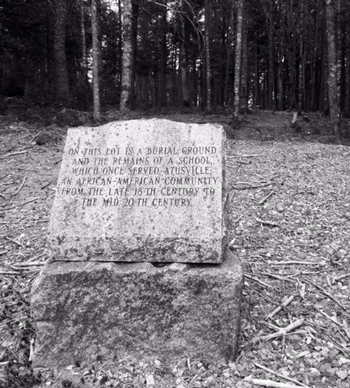Lost African-American Community Gaining Area’s Renewed Interest
by Lora Whelan

Marking the lost African-American settlement of Atusville in Machias is this monument put in place in 2005 after UMM students and faculty worked with Machias residents and records to bring the community’s folklore and history back to light. Photo courtesy Tara LiBrizzi
The ghosts of past glories and injustices reach into the present and speak to those who are listening, says University of Maine at Machias Professor of English Marcus LiBrizzi. At a recent presentation to the Pembroke Historical Society about the lost African American settlement of Atusville located in Machias, LiBrizzi described how the settlement came back to life as UMM students and faculty worked with Machias residents and records to give voice to the neglected, overgrown land that once comprised a burial ground, a school and a small community of houses that nurtured African Americans from the 18th century into the 20th. Ghosts may be teased out from census data or they may make themselves known, and LiBrizzi isn’t about to discount either way of learning about the people who once called a place home.
With the 2009 publication of Lost Atusville: A Black Settlement from the American Revolution, LiBrizzi made available to a wider audience the findings of the Maine Humanities Council funded project that brought together UMM specialists in folklore, history and archaeology, all prompted by the early curiosity of a student interested in local history who had heard about the former settlement. The community was formed in the 1770s by former slaves, at least two of whom had served in the American Revolution and were war heroes: London Atus and Richard Earle. Ideals from the newly formed nation were in full swing and came to roost in the hearts and minds of those African Americans living in Machias. As free people, whether they purchased their freedom or were freed with the gradual abolition of slavery in New England starting in 1784, the Atusville residents were proud of their role in gaining the country’s independence. Intermarriage with whites and Native Americans occurred regularly, with the families expanding quickly into multi generational households.
However, LiBrizzi points to the contradictory nature of the African American community embedded in the middle of a white one. Atusville was one of eight in the state that flourished during the maritime heyday, but as the 19th century marched onward the early idealism of the revolutionary period faded. The formative days of intermarriage pointed to a progressive community. The donation of five acres by a black family for the site of a burial ground not specifically designated for African Americans also pointed to the progressive nature of at least some of the residents. However, 12 years later in 1853 a school for Atusville children was built smack in the middle of the cemetery after the children were bullied by white children to such a degree that they refused to attend the town’s school.
Atusville residents never attained wealth. If they did it was far from the reaches of Machias. The burial grounds were marked by mounded graves, and if they had markers they were of wood. By 1980 when the Town of Machias proposed to dig up the site for gravel and to use “the material” from the burial ground in the town’s sewer project, there were no markers to distinguish graves and no records in the town office of who had been buried there and where. The memory of Atusville had begun to recede. However, the town’s proposal became a rallying cry, with horror at the thought of such desecration galvanizing those who remembered the community to put their collective foot down.
LiBrizzi points to the moment as the beginning of a turning point for the lost settlement, but it was slow going that continues into the present, as research still continues to find descendants who may have family stories to share. Today the site is marked by a modest monument.
“Towards the end the last few residents were living in deplorable conditions,” LiBrizzi says. “But it was more than poverty and injustice that would give rise to restless spirits.” The ghosts may not be completely satisfied with the story told so far. A 1795 riot against an Atusville woman who had brought a paternity suit against a prominent white man was one such terrible time. The bullying of the school age children by their white peers is another. LiBrizzi notes that an occasional photograph taken at the old burial grounds has shown strange shapes, and a house with a corner built on the site of the last house to remain into the mid 20th century could not have pictures hung on the wall. The owner finally gave up and stopped hanging anything in that corner.
What started in 2001 as a modest student project on “buried diversity” has continued to shed light and grow with the monument, the book publication, the clearing of the burial grounds, a “virtual Atusville” and the continued research and collection of the stories and folklore of the community’s past.
This article was first published in the Quoddy Tides.
